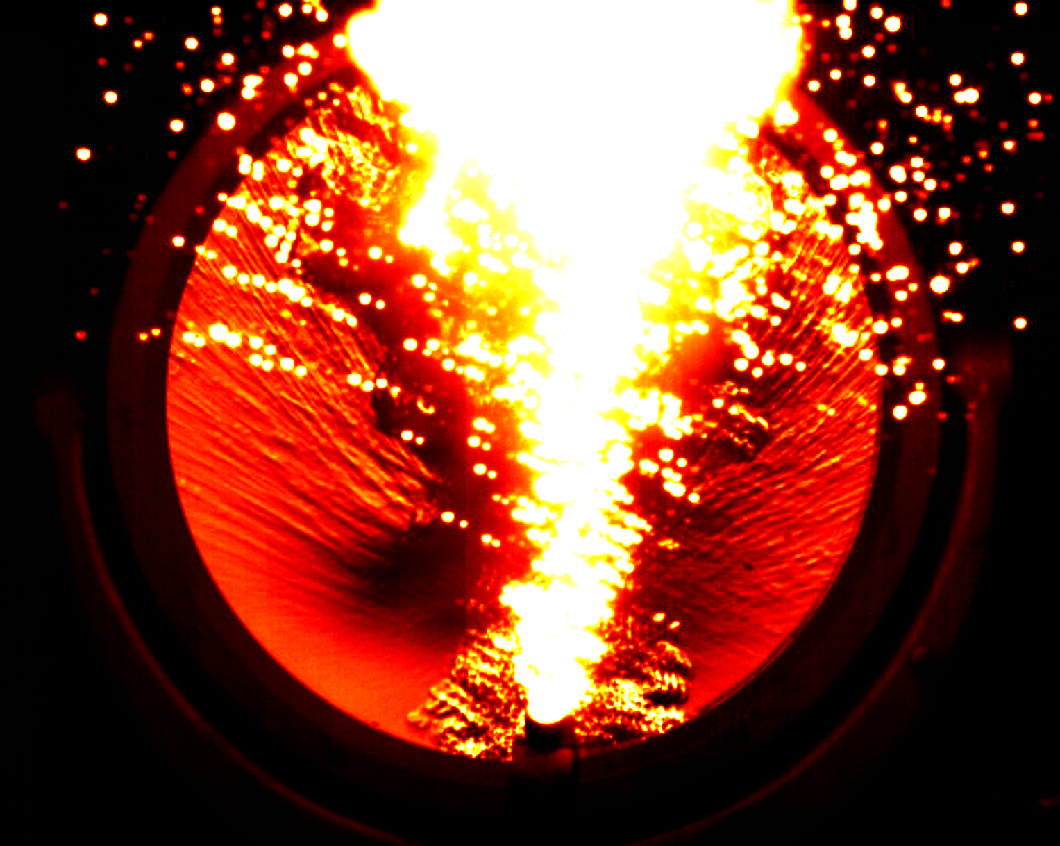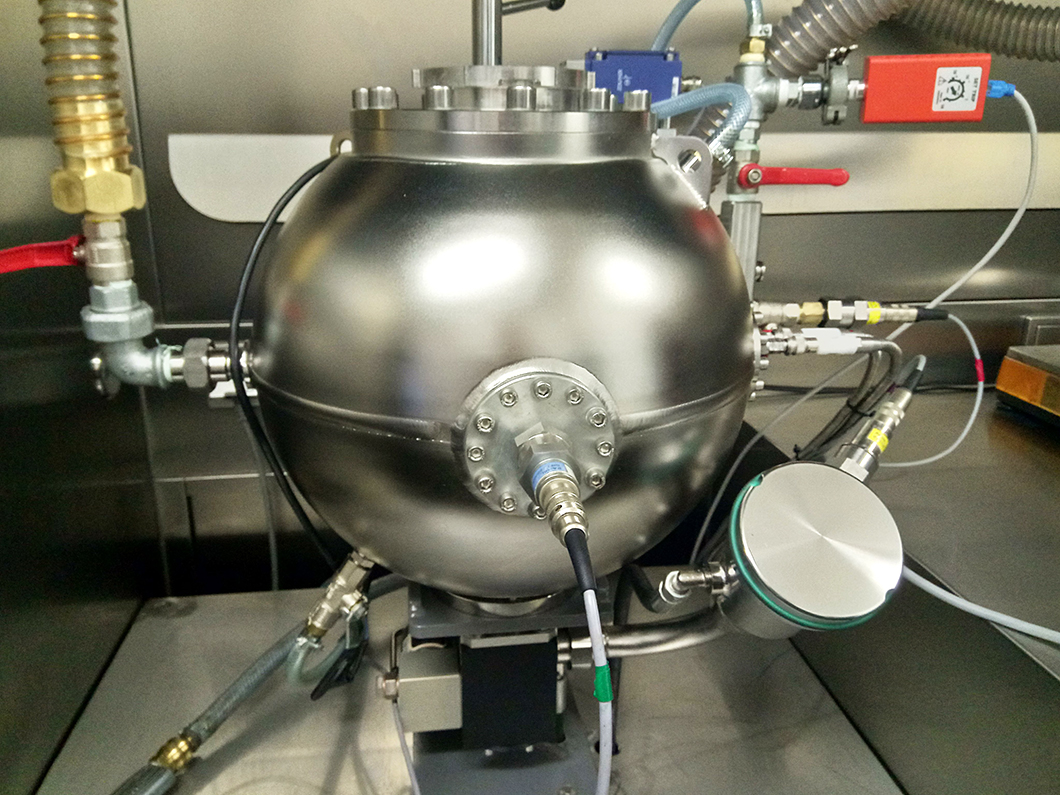
Determination of the duration and burning volume of a pyrotechnic igniter with an ignition energy of 5000 J: High-speed (10,000 fps) Schlieren recording
Source: BAM, division Explosion Protection Gases and Dusts
Project period
01/03/2019 - 28/02/2022
Project type
Collaborative research project
Project status
Closed
Description
Nex-Hys - In the project, a standard procedure is being developed for determining safety characteristics for explosion protection for hybrid mixtures of combustible dust and combustible gas.
Location
Bundesanstalt für Materialforschung und -prüfung
Unter den Eichen 87
12205 Berlin
High-Speed (10.000 fps) Schlieren recording of an exploding wire Source: BAM
Hybrid mixtures consist of combustible substances of different phases (e.g. dust-fuel gas mixtures). They occur, for example, in plants for wood gasification or biomass gasification and in plants for plastics production. Depending on the substance system, safety characteristics (SC) for explosion protection can be strongly dependent on the equipment parameters used for determination. There is currently no standard procedure for the determination of STC of hybrid dust-gas mixtures.
Source: BAM
In order to determine the limit parameters at which an explosion is no longer possible (explosion limits, limiting oxygen concentration) or to quantify the extent of an explosion (explosion pressure, rate of pressure rise), different or differently strong ignition sources are used. For both fuel-gas-air mixtures and dust-air mixtures, the 20 L sphere is a suitable test apparatus for laboratory scale. In principle, it is also suitable for hybrid mixtures.
Source: BAM
The joint project deals with all aspects of the development of test procedures and test equipment for the determination of safety-related parameters of hybrid mixtures and with the preparation of corresponding standards. BAM's main task is the development of a standardisable ignition source and the testing of mixture formation.
Source: BAM
Within the framework of the WiPaNo joint project "NEX-HYS - Development of standardisable determination procedures for safety-related parameters of explosion protection for hybrid mixtures", the following institutions are experimentally involved in addition to BAM: Otto-von-Guericke-Universität Magdeburg, Institute for Apparatus and Environmental Engineering | PTB - Physikalische Technische Bundesanstalt, Division Fundamentals of Explosion Protection | Inburex Consulting GmbH | DIN e.V. Normenausschuss Sicherheitstechnische Grundsätze (NASG)
Nex-Hys - Development of standard determination methods for safety characteristics of explosion protection for hybrid mixtures
Hybrid mixtures are mixtures of substances in at least two different flammable phases, e.g. dust-gas mixtures or gas-mist mixtures. They occur, among other things, in plants for wood gasification or biomass gasification and in plants for plastics production. Depending on the substance system, the safety characteristics (SC) for explosion protection can be very strongly dependent on the equipment parameters used to determine them.
The focus of the project is on the parameters maximum rate of pressure rise, maximum rate of pressure rise over time and oxygen limit concentration. Current investigations from practice and research on the SC of hybrid mixtures are oriented to the standards for gases, vapours and dusts. One difficulty here is that the standards differ in essential parts. There are particularly large differences in the ignition sources and the mixing procedure. With regard to the ignition energy, the ignition sources differ by three to four orders of magnitude.

20L sphere with additional pressure sensors
Source: BAM, division Explosion Protection Gases, Dusts
Ignition sources
The first objective is to characterise and compare the ignition sources described in various standards for the determination of SC with regard to the energy introduced, the ignition duration and the initial volume in order to draw conclusions about their effectiveness. For this purpose, calorimetric measurements and high-speed recordings of the different ignition sources are carried out. In order to be able to better estimate the initial volume, Schlieren recordings will also be made in the course of the project. Subsequently, the influence of the ignition energy and the type of igniter on the safety characteristics for different substance systems is to be systematically determined by ignition tests in a 20L sphere modified within the scope of this work. Furthermore, a suitable ignition source for the determination of the SC of hybrid mixtures is to be identified.
Turbulence
The differences in the mixing procedure also lead to different results: When determining the SC of dusts, there is a high turbulence within the ignition vessel because the dust must be elevated for the ignition process. In the case of gases and vapours, however, a quiescent mixture is ignited in order not to influence the flame propagation and to achieve the highest possible reproducibility. Since turbulence has a great influence on some STK, the difference was investigated.
Mixing process
In previous investigations of hybrid mixtures, the fuel gas is added to the mixture in three different ways: The fuel gas is exclusively in the 20L sphere before injecting the dust, exclusively in the dust supply container, or a homogeneous premix is in both. In the first two methods mentioned, it is assumed that the theoretical calculation of the fuel gas proportion by means of partial pressures is error-free and that complete mixing takes place. Literature research showed that subsequent verification of the fuel gas fraction has not yet taken place, nor have comparisons between the different methods to confirm the assumptions.
Project coordination
Otto-von-Guericke-Universität Magdeburg, Institute for Apparatus and Environmental Engineering
Partners
BAM - division Explosion Protection Gases and Dusts
Otto-von-Guericke-Universität Magdeburg, Institute for Apparatus and Environmental Engineering
PTB - Physikalische Technische Bundesanstalt, Division Fundamentals of Explosion Protection
Inburex Consulting GmbH
DIN e.V. Normenausschuss Sicherheitstechnische Grundsätze (NASG)
Funding
The Nex-Hys project is funded by the German Federal Ministry for Economic Affairs and Climate Action (BMWK) as part of the programme WIPANO - Knowledge and Technology Transfer through Patents and Standards, funding code 03TNH006C.

Source: BMWi, WIPANO


